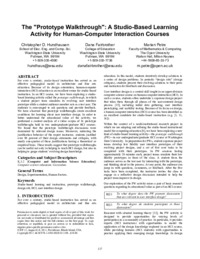The «prototype walkthrough»a studio-based learning activity for human-computer interaction courses
Publikationsdatum:
Zu finden in: ICER 2011 (Seite 117 bis 124), 2011
|
 |
 Diese Seite wurde seit 5 Jahren inhaltlich nicht mehr aktualisiert.
Unter Umständen ist sie nicht mehr aktuell.
Diese Seite wurde seit 5 Jahren inhaltlich nicht mehr aktualisiert.
Unter Umständen ist sie nicht mehr aktuell.
 Zusammenfassungen
Zusammenfassungen
For over a century, studio-based instruction has served as an effective pedagogical model in architecture and fine arts education. Because of its design orientation, human-computer interaction (HCI) education is an excellent venue for studio-based instruction. In an HCI course, we have been exploring a studio-based learning activity called the prototype walkthrough, in which a student project team simulates its evolving user interface prototype while a student audience member acts as a test user. The audience is encouraged to ask questions and provide feedback. We have observed that prototype walkthroughs create excellent conditions for learning about user interface design. In order to better understand the educational value of the activity, we performed a content analysis of a video corpus of 16 prototype walkthroughs held in two undergraduate/graduate HCI courses. We found that the prototype walkthrough discussions were dominated by relevant design issues. Moreover, mirroring the justification behavior of the expert instructor, students justified over 80 percent of their design statements and critiques, with nearly one-quarter of those justifications having a theoretical or empirical basis. These results suggest that prototype walkthroughs can be useful not only in helping to teach HCI design, but also in helping to gauge students' evolving design knowledge.
 Dieses Konferenz-Paper erwähnt ...
Dieses Konferenz-Paper erwähnt ...
 Anderswo finden
Anderswo finden
 Volltext dieses Dokuments
Volltext dieses Dokuments
 |  The "prototype walkthrough": Fulltext at the ACM Digital Library ( The "prototype walkthrough": Fulltext at the ACM Digital Library ( : :  , 537 kByte; , 537 kByte;  : :  2020-11-28) 2020-11-28) |
 Anderswo suchen
Anderswo suchen 
 Beat und dieses Konferenz-Paper
Beat und dieses Konferenz-Paper
Beat hat Dieses Konferenz-Paper während seiner Zeit am Institut für Medien und Schule (IMS) ins Biblionetz aufgenommen. Beat besitzt kein physisches, aber ein digitales Exemplar. Eine digitale Version ist auf dem Internet verfügbar (s.o.). Aufgrund der wenigen Einträge im Biblionetz scheint er es nicht wirklich gelesen zu haben. Es gibt bisher auch nur wenige Objekte im Biblionetz, die dieses Werk zitieren.











 Biblionetz-History
Biblionetz-History